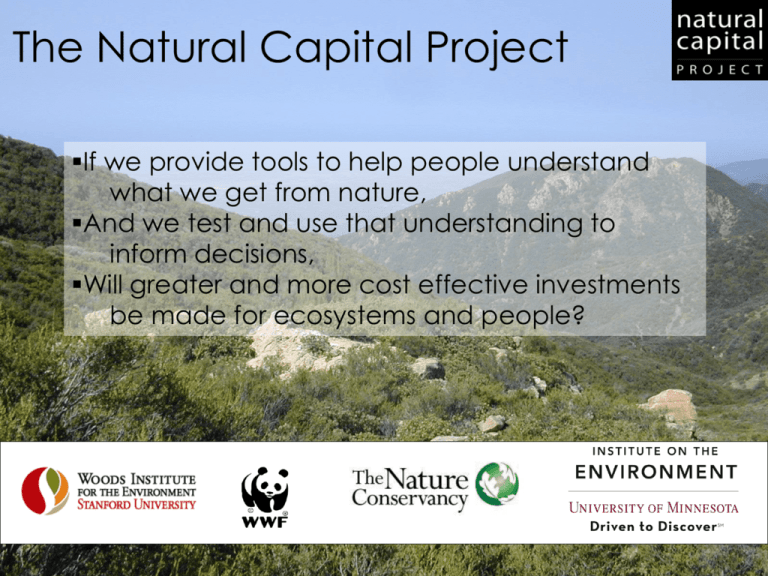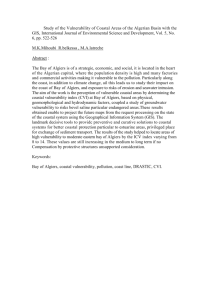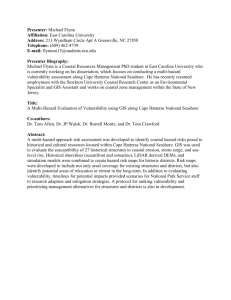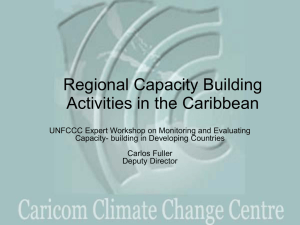NatCap_woods_short - Natural Capital Project
advertisement

The Natural Capital Project If we provide tools to help people understand what we get from nature, And we test and use that understanding to inform decisions, Will greater and more cost effective investments be made for ecosystems and people? food happiness water livelihoods energy health protection climate regulation InVEST Recreation Aquaculture: finfish Fisheries http://www.naturalcapitalproject.org/ Sediment retention Water purification Crop pollination Coastal Vulnerability Hydropower Wave Energy Biodiversity Carbon sequ’n Commercial timber Agricultural prod’n Flood control Irrigation water Aesthetic Quality Water Quality Habitat Risk Assmt Carbon Sequestration Coastal Protection Aquaculture: shellfish NTFPs Production Function NAS 2005, Daily et al 2009 An example starting with one service….. Where do habitats provide protection? Who or what is protected? What is cost effectiveness of alternative protection approaches? Nearshore Wave and Erosion Model Erosion and flooding hazards mangroves marshes seagrass beds oyster reef coral reefs sand dunes transmission coefficient friction factor wave height depth distance period wavelength shoaling coefficient Beach Offshore Erosion Difference: 1.5m Guannel et al. 2012 Influence of natural habitat on coastal vulnerability In Monterey Bay Kelp Wetlands (MLPA) Coastal Vulnerability VI 1 - 3 (Low) 3-4 4-6 (Medium) 6-10 10-16 (High) Natural Habitat (less) Natural Habitat (more) Kelp Wetlands (NWI) Wetlands (MLPA) Kelp Kelp Coastal Vulnerability Wetlands (MLPA) VI 1Coastal - 3 (Low) Vulnerability 3-4 VI VI 1 - 3 (Low) 3-4 4-6 (Medium) 1 - 3 (Low) 6-10 Coastal Vulnerability (NWI) 3-4 10-16 (High) 4-6 (Medium) 4-6 (Medium) 6-10 10-16 (High) Vulnerability of What? Of Whom? Elderly population Coastal Vulnerability VI 1 - 3 (Low) 3-4 TEXAS CITY 4-6 (Medium) 6-10 10-16 (High) SanatationPumpStations Vegetation Agriculture Coastal Vulnerability VI Urban DrainageJunctions 1 - 3 (Low) 3-4 Sanitation Drainage 4-6 (Medium) 6-10 DIFFERENCE IN C O A S TA L V U L N E R A B I L I T Y 10-16 (High) Non e Lowe st Highe st Input Data (reflect scenarios) Marine InVEST Models Model Outputs (ecosystem services & values) ECOSYSTEM VALUATION e.g. SERVICES Carbon Carbon Sequestered Value of carbon sequestered Energy Captured Value of captured wave energy Avoided Area Flooded/Erod ed Value of avoided damages TERRESTRIAL SYSTEMS Wave Energy 3 BIO-PHYSICAL 9 Bathymetry & Topography Species distribution Habitat Risk 5 Oceanography Coastal Protection Recreation Visitation Rates Expenditures due to recreation activity Fishery Landed Biomass Net present 4 7 Habitat type Water Quality 8 value of SOCIO-ECONOMIC Population density 1 6 2 Aquaculture Demographics Aquaculture operation costs Property values Aesthetic Quality Harvested Biomass finfish and shellfish Vancouver Island objectives: renewable, Compatibility: energy sustainable local energyWave sources, commercial recreation and fishing, commercial fisheries Kim et al, in review Testing many kinds of decision contexts Decision Context Geography Spatial Planning Tanzania, Indonesia, British Columbia, Hawaii, China, Belize Ecosystem-based management (terrestrial-marine links) Puget Sound, Galveston Bay, Chesapeake Bay Climate adaptation (ecosystem-based adaptation) Galveston Bay, Monterey Bay Return on restoration investments, PES schemes Colombia water funds, Gulf of Mexico, Indonesia, China Impact assessment, permitting, licensing Colombia mining concessions, agricultural practices in US Supply chain/LCA, business risk US, South America, global NatCap demonstration projects around the world…… • Using multiple ES in decisions is appealing, but early days • High demand for tools • Not all about PES, $ values • Decision makers can easily consider trade-offs in different (value) currencies • Working on: – jobs/livelihoods – beyond basic correlations for human well being







